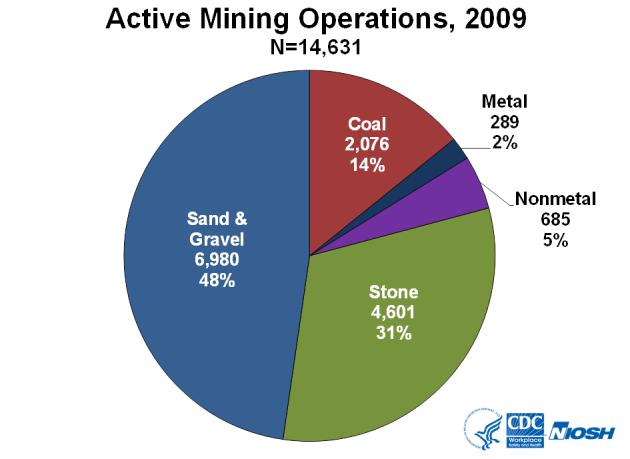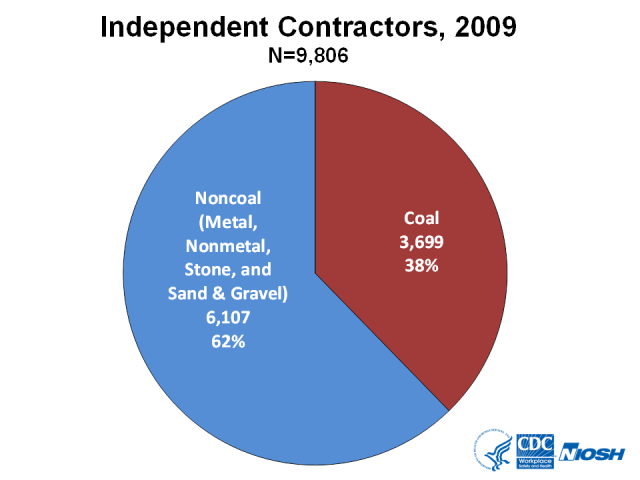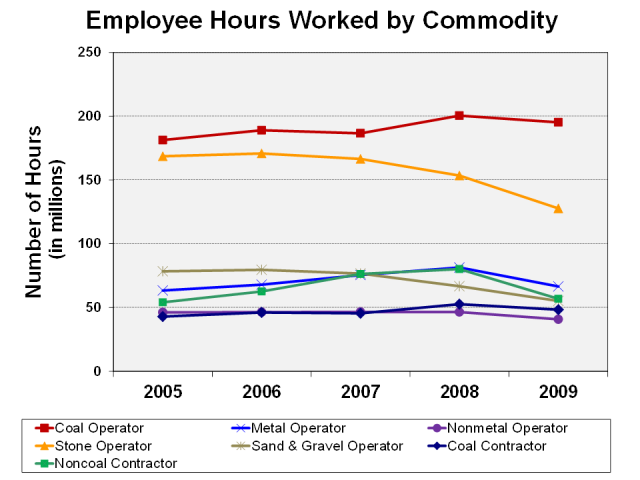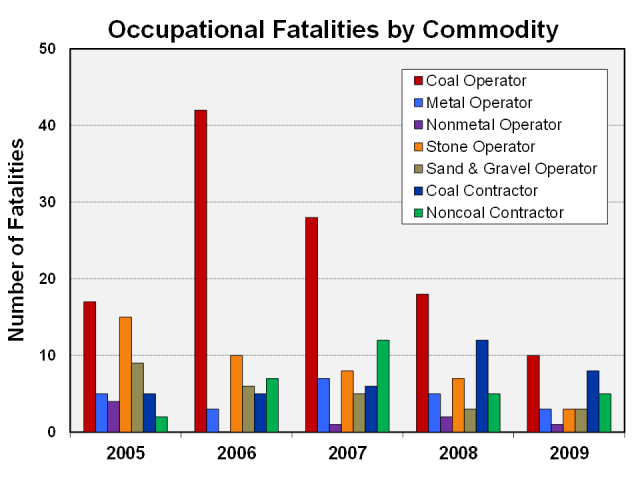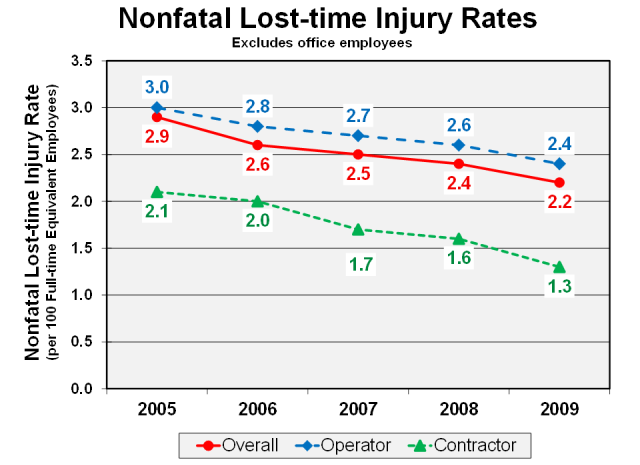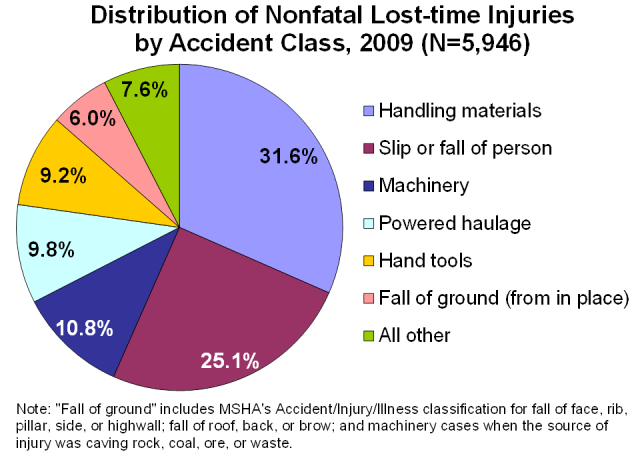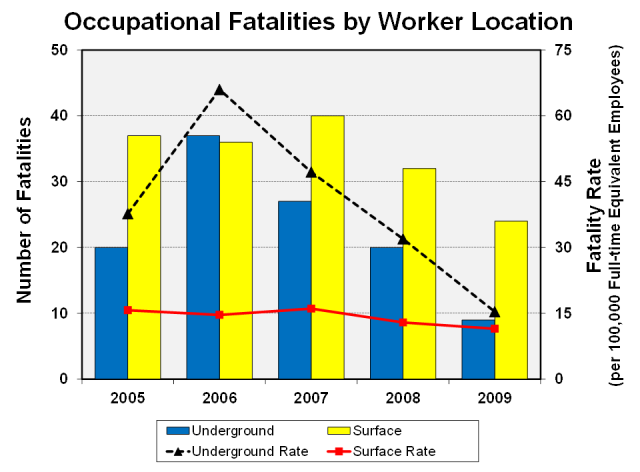Mining Facts - 2009
Overall Mining
The Mine Safety and Health Administration (MSHA) maintains data collected under the Code of Federal Regulations (30 CFR Part 50) on accidents, fatal and nonfatal injuries, illnesses, employment, and coal production. Summary data were obtained from the MSHA data files for mine operators and independent contractors working on mine property. See Statistical Methodology for further information.
Mining Operations
- In 2009, a total of 14,631 mining operations [1] reported employment data to MSHA.
- Almost half (47.7%) of the mines were sand & gravel mines, followed by stone mines (31.4%), coal mines (14.2%), nonmetal mines (4.7%), and metal mines (2.0%).
- Mines reporting to MSHA are located in all 50 states, Puerto Rico, and the Virgin Islands. Pennsylvania had the most mines (n=957; 6.5%) followed by Kentucky (n=750; 5.1%) and Texas (n=713; 4.9%). Almost half (49.4%) of the active mining operations are located in the 13 topmost states.
- The top primary commodities produced at mines were sand & gravel (n=6,980; 47.7%) followed by crushed and broken limestone (n=2,021; 13.8%) and bituminous coal (n=1,918; 13.1%).
Click on the image to enlarge.
Data for the previous chart showing the number of active mining operations and percent of total by commodity in 2009 (N=14,631)
| Commodity | Number of Mines | Percent of Total |
|---|---|---|
| Coal | 2,076 | 14 |
| Metal | 289 | 2 |
| Nonmetal | 685 | 5 |
| Stone | 4,601 | 31 |
| Sand & Gravel | 6,980 | 48 |
Independent Contracting Companies
- An independent contractor is defined by MSHA as “any person, partnership, corporation, subsidiary of a corporation, firm, association or other organization that contracts to perform services or construction at a mine.” Contractors that perform specific types of work are required to report the number of employees who work at coal mines and noncoal mines.
- In 2009, a total of 9,806 independent contractors reported employment data to MSHA.
- There were 3,699 (37.7%) contracting companies working at coal mines and 6,107 (62.3%) contracting companies working at noncoal (metal, nonmetal, stone, and sand & gravel) mines.
Click on the image to enlarge.
Data for the previous chart showing the number of independent contracting companies and percent of total by commodity in 2009 (N=9,806)
| Commodity | Number of Companies | Percent of Total |
|---|---|---|
| Coal | 3,699 | 38 |
| Noncoal (Metal, Nonmetal, Stone, and Sand & Gravel) | 6,107 | 62 |
Employees
- There were 252,588 mine operator employees, [2] or 242,729 full-time equivalent (FTE) [3] workers.
- Within the mining commodities, [4] coal operators reported the most employees (n=90,885; 25.5%), followed by stone operators (n=70,261; 19.8%), noncoal contractors (n=59,928; 16.8%), coal contractors (n=43,204; 12.1%), sand & gravel operators (n=37,510; 10.5%), metal operators (n=32,902; 9.2%) and nonmetal operators (n=21,030; 5.9%).
- For mine operators, 22.3% of the employee hours were for underground work locations, and 77.7% of the employee hours were for surface work locations. [5]
-
Of the 103,132 independent contractor employees (or 52,604 FTE workers), 41.9% were coal contractor employees and 58.1% were noncoal (metal, nonmetal, stone, and sand and gravel) contractor employees.
Click on the image to enlarge.
Data for the previous chart showing the average number of employee hours (in millions) worked by commodity and year, 2005-2009
| Commodity | 2005 | 2006 | 2007 | 2008 | 2009 |
|---|---|---|---|---|---|
| Coal Operator | 181.3 | 189.0 | 186.5 | 200.4 | 195.2 |
| Metal Operator | 63.4 | 67.9 | 75.5 | 81.4 | 66.5 |
| Nonmetal Operator | 46.2 | 46.4 | 46.5 | 46.5 | 40.8 |
| Stone Operator | 168.6 | 170.8 | 166.5 | 153.5 | 127.7 |
| Sand & Gravel Operator | 78.4 | 79.6 | 76.7 | 66.7 | 55.2 |
| Coal Contractor | 43.0 | 46.2 | 45.5 | 52.6 | 48.3 |
| Noncoal Contractor | 54/1 | 62.6 | 76.3 | 80.2 | 56.9 |
Occupational Fatalities
- In 2009, there were 33 occupational mining fatalities with a rate of 12.3 [95% confidence interval (CI): 8.5, 17.3] per 100,000 FTE workers. This compares to 52 fatalities with a rate of 16.8 [CI: 12.5, 22.0] in 2008.
- The fatality rate for mine operator employees was 9.2 [CI: 5.6, 14.1] (n=20; 60.6%), while the rate for contractor employees was 26.5 [CI: 14.1, 45.2] (n=13; 39.4%).
- Coal contractors had the highest fatality rate of 35.4 [CI: 15.3, 69.7] (n=8; 24.2%), followed by noncoal contractors at 18.8 [CI: 6.1, 44.0] (n=5; 15.2%) and coal operators at 10.7 [CI: 5.1, 19.6] (n=10; 30.3%).
- The fatality rate at underground work locations was 15.4 [CI: 7.0, 29.2] per 100,000 FTE workers (n=9; 27.3%) compared to 11.5 [CI: 7.4, 17.1] (n=24; 72.7%) at surface work locations.
Click on the image to enlarge.
Data for the previous chart showing the number of occupational fatalities by commodity and year, 2005-2009 (excludes office employees)
| Commodity | 2005 | 2006 | 2007 | 2008 | 2009 |
|---|---|---|---|---|---|
| Coal Operator | 17 | 42 | 28 | 18 | 10 |
| Metal Operator | 5 | 3 | 7 | 5 | 3 |
| Nonmetal Operator | 4 | 0 | 1 | 2 | 1 |
| Stone Operator | 15 | 10 | 8 | 7 | 3 |
| Sand & Gravel Operator | 9 | 6 | 5 | 3 | 3 |
| Coal Contractor | 5 | 5 | 6 | 12 | 8 |
| Noncoal Contractor | 2 | 7 | 12 | 5 | 5 |
Nonfatal Lost-time Injuries
- There were 5,946 nonfatal lost-time injuries in 2009 (2,328 at underground and 3,618 at surface work locations).
- These injuries occurred at an overall rate of 2.2 [CI: 2.2, 2.3] per 100 FTE workers and resulted in a total of 373,689 days lost from work. [6]
-
The underground nonfatal lost-time injury rate was greater than the surface injury rate (4.0 [CI: 3.8, 4.1] vs. 1.7 [CI: 1.7, 1.8] per 100 FTE workers).
Click on the image to enlarge.
Data for the previous chart showing the overall, operator, and contractor nonfatal lost-time injury rate (per 100 full-time equivalent employees) by year, 2005-2009 (excludes office employees)
| Year | Overall | Operator | Contractor |
|---|---|---|---|
| 2005 | 2.9 | 3.0 | 2.1 |
| 2006 | 2.6 | 2.8 | 2.0 |
| 2007 | 2.5 | 2.7 | 1.7 |
| 2008 | 2.4 | 2.6 | 1.6 |
| 2009 | 2.2 | 2.4 | 1.3 |
- The back was the most frequently reported body part injured, accounting for 1,038 nonfatal lost-time injuries, 75,429 days lost from work, and 20.2% of all days lost.
- Sprains or strains was the most frequently reported nature of injury (n=2,592; 43.6%).
Click on the image to enlarge.
Data for the previous chart showing the distribution of nonfatal lost-time injuries by accident class, 2009 (N=5,946)
| Accident Class | Percent |
|---|---|
| Handling materials | 31.6 |
| Slip or fall of person | 25.1 |
| Machinery | 10.8 |
| Powered haulage | 9.8 |
| Hand tools | 9.2 |
| Fall of ground (from in place) | 6.0 |
| All other | 7.6 |
Underground and Surface Mining
Mining Operations
- Data obtained from MSHA indicated a total of 872 underground (6.0%) and 13,759 surface (94.0%) mining operations.
- The commodity with the highest number of active mines was sand & gravel (n=6,980). All sand & gravel mining is performed at surface work locations.
Employees
- A total of 57,618 employees, or 58,550 FTE employees, were reported to MSHA as working at underground mining locations in 2009. This is in contrast to 298,102 employees (or 236,783 FTE employees) who were reported as working at surface locations.
- Surface work location employee hours accounted for 80.2% of all hours reported to MSHA, while 19.8% of employee hours were reported for underground work locations.
- The majority of surface employee hours were for mine operator employees (79.6%) as opposed to independent contractor employees (20.4%).
- Coal operators were the mining sector reporting the most underground worker employee hours to MSHA (n=90,345,910; 77.2%).
Occupational Fatalities
- Of the 33 occupational mining fatalities reported to MSHA in 2009, 9 occurred at underground work locations, and 24 occurred at surface locations.
- The rate of fatalities at underground work locations was 15.4 [95% confidence interval (CI): 7.0, 29.2] per 100,000 FTE employees. This compares to the lower fatality rate at surface work locations of 11.5 [CI: 7.4, 17.1].
Click on the image to enlarge.
Data for the previous chart showing the number and rate (per 100,000 full-time equivalent employees) of occupational fatalities by worker location and year, 2005-2009 (excludes office employees)
| Year | Underground Number | Underground Rate | Surface Number | Surface Rate |
|---|---|---|---|---|
| 2005 | 20 | 37.7 | 37 | 15.7 |
| 2006 | 37 | 66.0 | 36 | 14.6 |
| 2007 | 27 | 47.2 | 40 | 16.1 |
| 2008 | 20 | 32.0 | 32 | 12.9 |
| 2009 | 9 | 15.4 | 24 | 11.5 |
Nonfatal Lost-time Injuries
- Within underground work locations, 2,328 nonfatal lost-time injuries were reported, resulting in 174,598 days lost from work. This compares to 3,618 nonfatal lost-time injuries attributed to surface workers resulting in 199,091 days lost from work.
- The overall underground nonfatal lost-time injury rate was greater than the surface injury rate (4.0 [CI: 3.8, 4.1] vs. 1.7 [CI: 1.7, 1.8] per 100 FTE workers).
- The most frequent classification of nonfatal lost-time injuries involved handling materials for both underground (n=671; 28.8%) and surface (n=1,206; 33.3%) work locations.
- The back was the most frequently reported body part injured at both underground (n=387; 16.6%) and surface (n=651; 18.0%) work locations.
Coal and Metal/Nonmetal Mining
Mining Operations
- Data obtained from MSHA indicated 2,076 active coal (14.2%) and 12,555 metal/nonmetal (85.8%) mining operations.
- There were 26 states reporting coal mining operations. Approximately 73% of these mines were located in three states: Kentucky (n=619; 29.8%), West Virginia (n=467; 22.5%), and Pennsylvania (n=425; 20.5%).
- Metal/nonmetal mines were distributed across all states, Puerto Rico, and the Virgin Islands. Texas reported the most metal/nonmetal mines (n=698, 5.6%).
Independent Contracting Companies
- In 2009, independent contracting companies reported employment at 3,699 coal mines and 6,107 metal/nonmetal mines.
Employees
- A total of 134,089 mine operator and independent contractor employees, or 121,744 FTE employees, were reported to MSHA as working at coal mines.
- Metal/nonmetal mines reported 221,631 employees (or 173,588 FTE employees).
Occupational Fatalities
- Of the 33 occupational mining fatalities reported to MSHA in 2009, 18 occurred at coal mining operations, while 15 occurred at metal/nonmetal mines.
- The fatality rate of 15.5 [CI: 9.2, 24.4] per 100,000 FTE employees was higher at coal mining operations, compared to the rate of 9.9 [CI: 5.6, 16.4] for metal/nonmetal mines.
Nonfatal Lost-time Injuries
- There were 3,110 nonfatal lost-time injuries reported at coal mining operations, resulting in 234,827 days lost from work. This compares to 2,836 nonfatal lost-time injuries attributed to metal/nonmetal mine workers with 138,862 days lost from work.
- The coal mine nonfatal lost-time injury rate was greater than the metal/nonmetal mine rate (2.7 [CI: 2.6, 2.8] vs. 1.9 [CI: 1.8, 1.9] per 100 FTE workers).
- The most frequent accident classification of nonfatal lost-time injuries involved handling materials for both coal (n=920; 29.6%) and metal/nonmetal mines (n=957; 33.7%).
- Sprains or strains was the most frequently reported nature of injury for both coal (n=1,318; 42.4%) and metal/nonmetal (n=1,274; 44.9%) mining operations.
Coal Mine Operators
Mining Operations
- In 2009, a total of 2,076 coal mining operations reported employment MSHA. Coal mines comprised 14.2% of all mining operations.
- Bituminous mines comprised 92.4% (n=1,918) and anthracite mines 7.6% (n=158) of coal mining operations.
- Approximately 73% of all coal mines were located in three states: Kentucky (n=619; 29.8%), West Virginia (n=467; 22.5%), and Pennsylvania (n=425; 20.5%).
Employees
- A total of 90,885 employees, corresponding to 97,580 FTE employees, were reported by coal mine operators to MSHA.
- Within the mining sectors, coal operators comprised 33.0% of all employee hours reported.
- Underground work locations accounted for 46.3% of employee hours, and surface work locations accounted for 53.7%.
Occupational Fatalities
- Ten occupational fatalities occurred among coal mine operator employees in 2009, compared to 18 in 2008.
- Fatalities among coal operator employees accounted for 30.3% of all mining fatalities.
- The coal operator fatality rate was 10.7 [95% confidence interval (CI): 5.1, 19.6] fatalities per 100,000 FTE employees. The underground fatality rate was 13.3 [CI: 4.9, 28.9] (n=6). There were 4 fatalities reported at surface work locations (no rate is calculated when number is less than 5).
Nonfatal Lost-time Injuries
- There were 2,700 nonfatal lost-time injuries (1,943 at underground and 757 at surface work locations) among coal operator employees occurring at an overall rate of 2.9 [CI: 2.8, 3.0] injuries per 100 FTE employees. These injuries resulted in 206,921 days lost from work, comprising 55.4% of days lost across all mining sectors.
- The underground nonfatal lost-time injury rate was greater than the surface injury rate (4.3 [CI: 4.1, 4.5] vs. 1.6 [CI: 1.4, 1.7] per 100 FTE workers).
- The most frequent classification of nonfatal lost-time injuries for coal operator employees involved handling materials (n=791; 29.3%).
- Sprains or strains were the most frequently reported nature of injury (n=1,182; 43.8%).
- The back was the most frequently reported body part injured (n=480; 17.8%) and accounted for 49,321 days lost from work.
Metal Mine Operators
Mining Operations
- In 2009, a total of 289 metal mining operations reported employment MSHA.
- Metal mines were the smallest mining sector, comprising 2.0% of all mining operations.
- Gold mines comprised 46.7% (n=135) of all metal mining operations. Other common types of metal mines were iron ore (n=36; 12.5%) and copper ore (n=35; 12.1%).
- Nevada had the largest number of metal mines (n=50; 17.3%), followed by Alaska (n=31; 10.7%).
Employees
- A total of 32,902 employees, corresponding to 33,273 FTE employees, were reported by metal mine operators.
- Within the mining sectors, metal mine operator employees accounted for 11.3% of all employee hours reported to MSHA.
- Metal operator employee hours were reported for both underground (13.9%) and surface (86.1%) work locations.
Occupational Fatalities
- Three occupational fatalities occurred among metal mine operator employees in 2009. This compares to five occupational fatalities in 2008.
- Of these reported fatalities, one occurred at an underground work location, and two fatalities occurred at surface work locations.
Nonfatal Lost-time Injuries
- There were 556 nonfatal lost-time injuries (112 at underground and 444 at surface work locations) among metal operator employees occurring at an overall rate of 1.9 [CI: 1.7, 2.1] injuries per 100 FTE employees. A total of 25,812 days lost from work resulted from these injuries.
- The underground nonfatal lost-time injury rate was greater than the surface injury rate (2.4 [CI: 2.0, 2.9] vs. 1.8 [CI: 1.6, 2.0] per 100 FTE workers).
- The most frequent classification of nonfatal lost-time injuries involved handling materials (n=192; 34.5%), followed by slip or fall of person (n=149; 26.8%).
- Sprains or strains was the most frequently reported nature of injury (n=279; 50.2%).
- The back was the most frequently reported body part injured (n=107; 19.2%) and accounted for 4,976 days lost from work.
Nonmetal Mine Operator
Mining Operations
- In 2009, a total of 685 nonmetal mining operations reported employment to MSHA. Nonmetal mines comprised 4.7% of all mining operations.
- Mines producing clay (common) comprised 21.3% (n=146) of all nonmetal mining operations. This was followed by 92 nonmetal mines producing clay, ceramic, and refractory that are not elsewhere classified (13.4%).
- Nonmetal mining operations were located in all states and territories except Alaska, Delaware, Hawaii, New Hampshire, Rhode Island, Puerto Rico, and the U.S. Virgin Islands.
- Georgia was the state with the most nonmetal mining operations (n=55; 8.0%), followed by Texas (n=50; 7.3%).
Employees
- A total of 21,030 employees, corresponding to 20,410 FTE employees, were reported to MSHA by nonmetal mine operators.
- Within the mining sectors, nonmetal mine operator employees accounted for 6.9% of all employee hours reported.
- Employee hours were reported at underground (12.3%) and surface (87.7%) work locations.
Occupational Fatalities
-
There was one occupational fatality among nonmetal mine operators in 2009 occurring at an underground mining location. This compares to two fatalities reported in 2008.
Nonfatal Lost-time Injuries
- There were 386 nonfatal lost-time injuries (80 at underground and 306 at surface work locations) among nonmetal mine operator employees occurring at an overall rate of 2.2 [CI: 2.0, 2.4] injuries per 100 FTE employees. A total of 22,228 days lost from work resulted from these injuries.
- The underground nonfatal lost-time injury rate was greater than the surface injury rate (3.2 [CI: 2.5, 4.0] vs. 2.1 [CI: 1.8, 2.3] per 100 FTE workers).
- In 2009, the most frequent classification of nonfatal lost-time injuries involved handling materials (n=143; 37.0%), followed by slip or fall of person (n=114; 29.5%).
- Sprains or strains was the most frequently reported nature of injury (n=193; 50.0%), followed by fractures or chips (n=46; 11.9%), contusions or bruises (n=36; 9.3%), and cuts, lacerations or punctures (n=33; 8.5%).
- The back was the most frequently reported body part injured (n=67; 17.4%) and accounted for 4,039 days lost from work. This was followed by fingers (n=46; 11.9%) and the knee (n=44; 11.4%).
Stone Mine Operator
Mining Operations
- In 2009, a total of 4,601 stone mining operations reported employment to MSHA.
- Stone mines comprised 31.4% of all mining operations.
- Mines producing the primary commodity of limestone (crushed and broken) comprised the largest number of operations (n=2,021; 43.9%).
- Stone mining operations were located in all states and territories except Delaware.
- Pennsylvania had the most stone mines (n=418; 9.1%), followed by Texas (n=352; 7.7%).
Employees
- A total of 70,261 employees, corresponding to 63,862 FTE employees, were reported to MSHA by stone mine operators.
- Within the mining sectors, stone mine operator employees accounted for 21.6% of all employee hours reported.
- Stone operator employee hours were reported for both underground (2.8%) and surface (97.2%) work locations.
Occupational Fatalities
- There were three occupational fatalities reported among stone mine operator employees in 2009, compared to seven in 2008.
- One fatality occurred at a mill or preparation plant, and the other two fatalities occurred at other surface areas of the mine.
Nonfatal Lost-time Injuries
- There were 1,273 nonfatal lost-time injuries (37 at underground and 1,236 at surface work locations) among stone operator employees occurring at an overall rate of 2.4 [CI: 2.2, 2.5] injuries per 100 FTE employees. A total of 55,968 days lost from work resulted from these injuries, comprising 15.0% of days lost across all sectors.
- The nonfatal lost-time injury rate was 2.0 [CI: 1.4, 2.8] for underground and 2.4 [CI: 2.2, 2.5] per 100 FTE for surface work locations.
- The most frequent classification of nonfatal lost-time injuries for stone operator employees involved handling materials (n=434; 34.1%).
- Sprains or strains was the most frequently reported nature of injury (n=559; 43.9%).
- The back was the most frequently reported body part injured (n=224, 17.6%) and accounted for 10,695 days lost from work.
Sand & Gravel Mine Operator
Mining Operations
- In 2009, a total of 6,980 sand & gravel mining operations reported employment to MSHA.
- The largest mining sector was sand & gravel mining, comprising 47.7% of all operations.
- Sand & gravel mines were found throughout all 50 states and Puerto Rico.
- Minnesota had the largest number of sand & gravel mines (n=482; 6.9%).
Employees
- A total of 37,510 employees, corresponding to 27,603 FTE employees, were reported by sand & gravel mine operators.
- Within the mining sectors, sand & gravel mine operator employees accounted for 9.3% of all employee hours reported to MSHA.
- All sand & gravel operator hours reported were for surface work locations.
Occupational Fatalities
- Three occupational fatalities occurred among sand & gravel operator employees in 2009. This compared to three fatalities in 2008.
- One fatality occurred at a surface location of the mine, and the other two fatalities occurred at dredge locations.
Nonfatal Lost-time Injuries
- There were 372 nonfatal lost-time injuries among sand & gravel operator employees occurring at an overall rate of 1.6 [CI: 1.4, 1.7] injuries per 100 FTE employees. A total of 16,603 days lost from work resulted from these injuries.
- The most frequent classifications of nonfatal lost-time injuries for sand & gravel operator employees involved handling materials (n=117; 31.5%) and slip or fall of person (n=108; 29.0%).
- Sprains or strains was the most frequently reported nature of injury (n=152; 40.9%), followed by fractures or chips (n=63; 16.9%).
- The back was the most frequently reported body part injured (n=68; 18.3%). These injuries resulted in 2,884 days lost from work.
Coal Contractors
Independent Contracting Companies
-
In 2009, a total of 3,699 independent contracting companies reported employment at coal mines, or 37.7% of all independent contracting companies.
Employees
- A total of 43,204 employees, corresponding to 24,164 FTE employees, were reported by coal contractors.
- Within the mining sectors, coal contractor employees comprised 8.2% of all employee hours.
- Coal contractor employee hours were reported for both underground (12.9%) and surface (87.1%) work locations.
Occupational Fatalities
- Eight occupational fatalities occurred among coal contractor employees in 2009. These coal fatalities accounted for 61.5% of all contractor fatalities.
- The coal contractor fatality rate was 35.4 [CI: 15.3, 69.7] fatalities per 100,000 FTE employees.
- The underground rate was not calculated because the number of fatalities was less than 5 (n=1).
- The surface work location rate was 35.9 [CI: 14.4, 74.0] (n=7).
Nonfatal Lost-time Injuries
- There were 410 nonfatal lost-time injuries among coal contractor employees (130 at underground and 280 at surface work locations) with an overall rate of 1.8 [CI: 1.6, 2.0] injuries per 100 FTE employees. These injuries resulted in 27,906 days lost from work.
- The underground nonfatal lost-time injury rate was greater than the surface injury rate (4.2 [CI: 3.5, 4.9] vs. 1.4 [CI: 1.3, 1.6] per 100 FTE workers).
- The most frequent classification of nonfatal lost-time injuries involved handling materials (n=129; 31.5%), followed by slip or fall of person (n=102; 24.9%).
- Sprains or strains was the most frequently reported nature of injury (n=136; 33.2%).
- The back was the most frequently reported body part injured (n=64; 15.6%) and accounted for 2,812 days lost from work. This was followed by fingers (n=62; 15.1%) accounting for 3,306 days lost from work.
Noncoal Contractors
Independent Contracting Companies
-
In 2009, a total of 6,107 independent contracting companies reported employment at noncoal (metal, nonmetal, stone, and sand & gravel) mines, or 62.3% of all independent contracting companies.
Employees
- A total of 59,928 employees, corresponding to 28,440 FTE employees, were reported by noncoal contractors.
- Within the mining sectors, noncoal contractor employees comprised 9.6% of all employee hours.
- Noncoal contractor employee hours were reported for both underground (4.6%) and surface (95.4%) work locations.
Occupational Fatalities
- Five occupational fatalities occurred among noncoal contractor employees in 2009, accounting for 38.5% of all fatalities attributed to independent contractors.
- All the noncoal contractor fatalities occurred at surface work locations.
- The noncoal contractor fatality rate for all work locations was 18.8 [CI: 6.1, 44.0] fatalities per 100,000 FTE employees.
Nonfatal Lost-time Injuries
- There were 249 nonfatal lost-time injuries among noncoal contractor employees (26 at underground and 223 at surface work locations) with an overall rate of 0.9 [CI: 0.8, 1.1] injuries per 100 FTE employees. These injuries resulted in 18,251 days lost from work.
- The underground nonfatal lost-time injury rate was 2.0 [CI: 1.3, 2.9], while the surface rate was 0.9 [CI: 0.8, 1.0] per 100 FTE workers.
- The most frequent classification of nonfatal lost-time injuries involved handling materials (n=71; 28.5%), followed by slip or fall of person (n=69; 27.7%).
- Sprains or strains was the most frequently reported nature of injury (n=91; 36.5%) for noncoal contractor employees.
- The most frequently reported body part injured was the fingers (n=36; 14.5%) These injuries resulted in 2,488 days lost from work.
Notes
Publicly released employment and accident/injury/illness data collected by the Mine Safety and Health Administration (MSHA) under the Code of Federal Regulations (30 CFR 50). All analyses of accident data exclude office employees. Occupational fatalities exclude all cases under 17 years of age. Caution should be used when interpreting rates based on a small number of events.
[1] Both mine operator and independent contractor employees work at mining operations. Active mines are those that report any mine operator employment. Mines at which only independent contractors were working and did not show any operator employment were not counted.
[2] Average number of employees working at individual mines during calendar quarters of active operations (includes office workers).
[3] Full-time equivalent employees computed using reported employee hours (2,000 hours = 1 FTE; includes office workers).
[4] Mining commodity and type of employer classes include coal operators, metal operators, nonmetal operators, stone operators, sand & gravel operators, coal contractors, and noncoal (metal, nonmetal, stone, and sand & gravel) contractors.
[5] Surface work locations include surface operations at underground mines, surface operations (strip or open pit), dredge, other surface operations, independent shops and yards, and mills or preparation plants.
[6] Total days lost includes actual days away from work and/or days of restricted work activity. For permanently disabling injuries only, statutory days charged by MSHA were used if they exceeded the total lost workdays.
Data Tables
Active Mining Operations, 2009
| Commodity | Underground | Surface | Total |
|---|---|---|---|
| Coal | 625 | 1,451 | 2,076 |
| Metal | 95 | 194 | 289 |
| Nonmetal | 44 | 641 | 685 |
| Stone | 108 | 4,493 | 4,601 |
| Sand & Gravel | 0 | 6,980 | 6,980 |
| TOTAL | 872 | 13,759 | 14,631 |
Employment Characteristics, 2009
| Commodity and Type of Employer | Underground Employees | Surface Employees | Total Employees | Underground FTE Employees | Surface FTE Employees | Total FTE Employees |
|---|---|---|---|---|---|---|
| Coal Operator | 41,262 | 49,623 | 90,885 | 45,173 | 52,407 | 97,580 |
| Metal Operator | 4,791 | 28,111 | 32,902 | 4,635 | 28,638 | 33,273 |
| Nonmetal Operator | 2,459 | 18,571 | 21,030 | 2,516 | 17,894 | 20,410 |
| Stone Operator | 1,761 | 68,500 | 70,261 | 1,808 | 62,054 | 63,862 |
| Sand & Gravel Operator | 0 | 37,510 | 37,510 | 0 | 27,603 | 27,603 |
| Operator Total | 50,273 | 202,315 | 252,588 | 54,132 | 188,597 | 242,729 |
| Coal Contractor | 5,347 | 37,857 | 43,204 | 3,114 | 21,050 | 24,164 |
| Noncoal Contractor | 1,998 | 57,930 | 59,928 | 1,304 | 27,136 | 28,440 |
| Contractor Total | 7,345 | 95,787 | 103,132 | 4,418 | 48,186 | 52,604 |
| TOTAL | 57,618 | 298,102 | 355,720 | 58,550 | 236,783 | 295,333 |
Note: Components may not sum to totals due to rounding
Occupational Fatalities, 2009
Rate per 100,000 full-time equivalent employees; 95% confidence interval
| Commodity and Type of Employer | Total Number | Total Rate | Total Lower CI | Total Upper CI |
|---|---|---|---|---|
| Coal Operator | 10 | 10.7 | 5.1 | 19.6 |
| Metal Operator | 3 | NC | NC | NC |
| Nonmetal Operator | 1 | NC | NC | NC |
| Stone Operator | 3 | NC | NC | NC |
| Sand & Gravel Operator | 3 | NC | NC | NC |
| Operator Total | 20 | 9.2 | 5.6 | 14.1 |
| Coal Contractor | 8 | 35.4 | 15.3 | 69.7 |
| Noncoal Contractor | 5 | 18.8 | 6.1 | 44.0 |
| Contractor Total | 13 | 26.5 | 14.1 | 45.2 |
| TOTAL | 33 | 12.3 | 8.5 | 17.3 |
Note: NC–Not calculated when N is less than 5
Occupational Fatalities (Underground), 2009
Rate per 100,000 full-time equivalent employees; 95% confidence interval
| Commodity and Type of Employer | Underground Number | Underground Rate | Underground Lower CI | Underground Upper CI |
|---|---|---|---|---|
| Coal Operator | 6 | 13.3 | 4.9 | 28.9 |
| Metal Operator | 1 | NC | NC | NC |
| Nonmetal Operator | 1 | NC | NC | NC |
| Stone Operator | 0 | NC | NC | NC |
| Sand & Gravel Operator | NA | NA | NA | NA |
| Operator Total | 8 | 14.8 | 6.4 | 29.1 |
| Coal Contractor | 1 | NC | NC | NC |
| Noncoal Contractor | 0 | NC | NC | NC |
| Contractor Total | 1 | NC | NC | NC |
| TOTAL | 9 | 15.4 | 7.0 | 29.2 |
Notes: NA–Not applicable; NC–Not calculated when N is less than 5
Occupational Fatalities (Surface), 2009
Rate per 100,000 full-time equivalent employees; 95% confidence interval
| Commodity and Type of Employer | Surface Number | Surface Rate | Surface Lower CI | Surface Upper CI |
|---|---|---|---|---|
| Coal Operator | 4 | NC | NC | NC |
| Metal Operator | 2 | NC | NC | NC |
| Nonmetal Operator | 0 | NC | NC | NC |
| Stone Operator | 3 | NC | NC | NC |
| Sand & Gravel Operator | 3 | NC | NC | NC |
| Operator Total | 12 | 7.3 | 3.8 | 12.8 |
| Coal Contractor | 7 | 35.9 | 14.4 | 74.0 |
| Noncoal Contractor | 5 | 19.8 | 6.4 | 46.3 |
| Contractor Total | 12 | 26.8 | 13.9 | 46.9 |
| TOTAL | 24 | 11.5 | 7.4 | 17.1 |
Note: NC–Not calculated when N is less than 5
Nonfatal Lost-time Injuries, 2009
Rate per 100 full-time equivalent employees; 95% confidence interval
| Commodity and Type of Employer | Total Number | Total Rate | Total Lower CI | Total Upper CI |
|---|---|---|---|---|
| Coal Operator | 2,700 | 2.9 | 2.8 | 3.0 |
| Metal Operator | 556 | 1.9 | 1.7 | 2.1 |
| Nonmetal Operator | 386 | 2.2 | 2.0 | 2.4 |
| Stone Operator | 1,273 | 2.4 | 2.2 | 2.5 |
| Sand & Gravel Operator | 372 | 1.6 | 1.4 | 1.7 |
| Operator Total | 5,287 | 2.4 | 2.4 | 2.5 |
| Coal Contractor | 410 | 1.8 | 1.6 | 2.0 |
| Noncoal Contractor | 249 | 0.9 | 0.8 | 1.1 |
| Contractor Total | 659 | 1.3 | 1.2 | 1.4 |
| TOTAL | 5,946 | 2.2 | 2.2 | 2.3 |
Nonfatal Lost-time Injuries (Underground), 2009
Rate per 100 full-time equivalent employees; 95% confidence interval
| Commodity and Type of Employer | Underground Number | Underground Rate | Underground Lower CI | Underground Upper CI |
|---|---|---|---|---|
| Coal Operator | 1,943 | 4.3 | 4.1 | 4.5 |
| Metal Operator | 112 | 2.4 | 2.0 | 2.9 |
| Nonmetal Operator | 80 | 3.2 | 2.5 | 4.0 |
| Stone Operator | 37 | 2.0 | 1.4 | 2.8 |
| Sand & Gravel Operator | NA | NA | NA | NA |
| Operator Total | 2,172 | 4.0 | 3.8 | 4.2 |
| Coal Contractor | 130 | 4.2 | 3.5 | 4.9 |
| Noncoal Contractor | 26 | 2.0 | 1.3 | 2.9 |
| Contractor Total | 156 | 3.5 | 3.0 | 4.1 |
| TOTAL | 2,328 | 4.0 | 3.8 | 4.1 |
Note: NA–Not applicable
Nonfatal Lost-time Injuries (Surface), 2009
Rate per 100 full-time equivalent employees; 95% confidence interval
| Commodity and Type of Employer | Surface Number | Surface Rate | Surface Lower CI | Surface Upper CI |
|---|---|---|---|---|
| Coal Operator | 757 | 1.6 | 1.4 | 1.7 |
| Metal Operator | 444 | 1.8 | 1.6 | 2.0 |
| Nonmetal Operator | 306 | 2.1 | 1.8 | 2.3 |
| Stone Operator | 1,236 | 2.4 | 2.2 | 2.5 |
| Sand & Gravel Operator | 372 | 1.6 | 1.4 | 1.7 |
| Operator Total | 3,115 | 1.9 | 1.8 | 2.0 |
| Coal Contractor | 280 | 1.4 | 1.3 | 1.6 |
| Noncoal Contractor | 223 | 0.9 | 0.8 | 1.0 |
| Contractor Total | 503 | 1.1 | 1.0 | 1.2 |
| TOTAL | 3,618 | 1.7 | 1.7 | 1.8 |
See Also
- Coal Operator Mining Facts - 2005
- Data & Statistics
- Metal Operator Mining Facts - 2002
- Metal Operator Mining Facts - 2004
- Metal Operator Mining Facts - 2005
- Mining Fact Sheets
- Noncoal Contractor Mining Facts - 2003
- Nonmetal Operator Mining Facts - 2002
- Nonmetal Operator Mining Facts - 2008
- Sand and Gravel Operator Mining Facts - 2006
- Statistical Methodology
- Stone Operator Mining Facts - 2003
- Stone Operator Mining Facts - 2005
- Page last reviewed: 11/16/2016
- Page last updated: 5/9/2017
- Content source: National Institute for Occupational Safety and Health, Mining Program


 ShareCompartir
ShareCompartir
